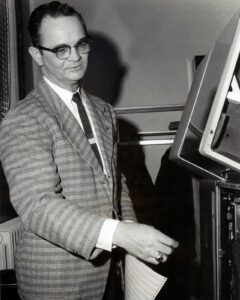
Computing on campus began with the Administrative Computer Center, which was established in the fall of 1967. The center was located in the Petty Science Building and placed under the direction of Dr. Roscoe Allen. It was formed to serve the administrative staff as well as the academic and research needs of its faculty and students. The demands of the center were met by an IBM 1401 computer that utilized IBM cards. Soon after in 1971, a new computer was purchased, the RCA 70/35 Spectra, a disk operating system with 65k bytes of memory. The new computer helped campus administration manage admissions, registration, student billing, electronic transcripts, and payroll.
Due to an increased workload and growing demands on the facility, the Administrative Computer Center was reorganized in 1973 and split into two units — the Academic Computer Center and the Administrative Computer Center. Campus administrators continued to use the existing campus computer, while faculty and students connected to the Triangle Universities Computation Center (TUCC) in Raleigh through a medium speed batch terminal connection.
The Administrative Computer Center remained under the direction of Roscoe Allen. With the division, the center stayed in the Petty Building and quarters were expanded to provide a reception area, Director’s office, and space for programming and systems staff. In 1982, after fifteen years as director, Roscoe Allen returned to full-time teaching as a professor in the Department of Business and Distributive Education. He was replaced by Dr. Eddy H. Cheng.
During the mid-1980s, Dr. Cheng designed a University Management Information System which significantly improved the computing capabilities of UNCG. It allowed campus administrative offices to access the main computer through their personal terminals and no longer required staff to go to the Forney Building, the center’s current location, to use it. By 1987, the center consisted of a staff of twenty-nine including the director.
With the need for a campus-wide computer network, the Administrative Computer Center and Academic Computer Center merged back into a single operation in 1990 becoming Computing and Information Systems. The new unit was placed under the control of Richard L. Moore as an interim director. He was replaced a year later by James Clotfelter. By this time, the campus had successfully completed installation of a broadband cable system. Also, a growing number of faculty offices had computers from which academics could access all of the computing and communications services offered across the campus.